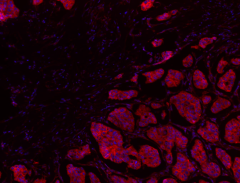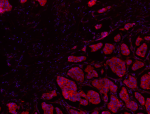- Clone
- H2Mab-77 (See other available formats)
- Regulatory Status
- RUO
- Other Names
- HER2/erbB2, tyrosine kinase cell surface receptor HER2, oncogene ERBB2, oncogene NGL, neuroblastoma- or glioblastoma-derived, HER-2
- Isotype
- Mouse IgG1, κ
- Ave. Rating
- Submit a Review
- Product Citations
- publications

-

Human paraffin-embedded HER2 positive patient breast cancer tissue slices were prepared with a standard protocol of deparaffinization and rehydration. Antigen retrieval was done with Citric buffer 1x pH 6.0 at 95°C for 40 minutes. Tissue was washed with PBS/0.05% Tween 20 twice for five minutes and blocked with 5% FBS and 0.2% gelatin for 30 minutes. Then, the tissue was stained with 10 µg/mL purified anti-human CD340 (erbB2/HER-2) (clone H2Mab-77) antibody overnight at 4°C. On the next day, tissue was incubate with Alexa Fluor® 594 goat anti-mouse IgG (Poly4053) antibody (red). Nuclei were counter-stained with DAPI (blue). The image was scanned with a 10X objective and stitched with MetaMorph® software. -

Human paraffin-embedded normal breast tissue slices were prepared with a standard protocol of deparaffinization and rehydration. Antigen retrieval was done with Citric buffer 1x pH 6.0 at 95°C for 40 minutes. Tissue was washed with PBS/0.05% Tween 20 twice for five minutes and blocked with 5% FBS and 0.2% gelatin for 30 minutes. Then, the tissue was stained with 10 µg/mL purified anti-human CD340 (erbB2/HER-2) (clone H2Mab-77) antibody overnight at 4°C. On the next day, tissue was incubate with Alexa Fluor® 594 goat anti-mouse IgG (Poly4053) antibody (red). Nuclei were counter-stained with DAPI (blue). The image was scanned with a 10X objective and stitched with MetaMorph® software.
| Cat # | Size | Price | Quantity Check Availability | Save | ||
|---|---|---|---|---|---|---|
| 399402 | 100 µg | 268€ | ||||
CD340 is also known as HER2/erbB2, tyrosine kinase cell surface receptor HER2, oncogene ERBB2, and oncogene NGL, neuroblastoma- or glioblastoma-derived. It is a member of the epidermal growth factor receptor family of cell membrane tyrosine kinases containing a single transmembrane domain and has an approximate molecular weight of 185 kD. CD340 contains three furin repeats and two cheY homologous receiver domains in the extracellular region (ECR). The HER2/erbB2 protein is expressed on many tumor cells, including some breast cancers, lung adenocarcinoma, gastric cancer, ovarian cancer, gliblastoma, some c-ALL blasts and bone marrow mesenchymal stem cells. Although the erbB2/HER2 protein contains no ligand binding domain, this protein interacts with other EGF receptor family members to form a heterodimer, stabilize ligand binding, and enhance kinase-mediated downstream signaling. CD340 has been shown to be involved in embryonic development and cancer progression; this protein is amplified in adenocarcinoma of the lung, some breast cancers, glioblastoma, gastric cancer, and ovarian carcinoma, where it functions as an oncogene. Overexpression of erbB2 in breast cancers has been shown to confer Taxol resistance and is a therapeutic target in a number of human cancers. The erbB2/HER-2 protein has been shown to interact with a large number of proteins, including SHC1, EGF receptorm, neuroregulin 1, c-Src, integrin β4, Grb2, Grb7, SOS1, caveolin 1, JAK2, PAK1, FAK, and β-catenin, among others. CD340 is extensively modified by tyrosine phosphoryation on multiple residues (Y1023, Y1139, Y1196, Y1221, Y1222, Y1248).
Product DetailsProduct Details
- Verified Reactivity
- Human
- Antibody Type
- Monoclonal
- Host Species
- Mouse
- Immunogen
- Recombinant HER2
- Formulation
- Phosphate-buffered solution, pH 7.2, containing 0.09% sodium azide
- Preparation
- The antibody was purified by affinity chromatography.
- Concentration
- 0.5 mg/mL
- Storage & Handling
- The antibody solution should be stored undiluted between 2°C and 8°C.
- Application
-
IHC-P - Quality tested
- Recommended Usage
-
Each lot of this antibody is quality control tested by formalin-fixed paraffin-embedded immunohistochemical staining. For immunohistochemistry, a concentration range of 5 - 10 µg/mL is suggested. It is recommended that the reagent be titrated for optimal performance for each application.
- RRID
-
AB_2890848 (BioLegend Cat. No. 399402)
Antigen Details
- Structure
- Member of the epidermal growth factor receptor family of cell membrane tyrosine kinases. Single transmembrane pass protein with an approximate molecular weight of 185 kD. Contains three furin repeats and two cheY homologous receiver domains in the ECR.
- Distribution
-
Expressed on many tumor cells including some breast cancers, lung adenocarcinoma, gastric cancer, ovarian cancer, gliblastoma, some c-ALL blasts and bone marrow MSCs.
- Function
- Contains no ligand binding domain and interacts with other EGF receptor family members to form a heterodimer, stabilize ligand binding, and enhance kinase-mediated downstream signaling. Involved in embryonic development and cancer progression.
- Interaction
- CD340 (HER2/erbB2) interacts with a large number of proteins, including SHC1, EGF receptorm, neuroregulin 1, c-Src, integrin β4, Grb2, Grb7, SOS1, caveolin 1, JAK2, PAK1, FAK, and β-catenin, among others.
- Antigen References
-
1. Akiyama T, et al. 1986. Science 232:1644.
2. Bargmann CI, et al. 1986. Nature 319:226.
3. Pegram MD, et al. 1997. Oncogene 15:537.
4. Slamon DJ, et al. 1989. Science 244:707.
5. Leone F, et al. 2003. J. Leukocyte Biol. 74:593. - Gene ID
- 2064 View all products for this Gene ID
- UniProt
- View information about CD340 on UniProt.org
Related Pages & Pathways
Pages
Related FAQs
Other Formats
View All CD340 Reagents Request Custom Conjugation| Description | Clone | Applications |
|---|---|---|
| Purified anti-human CD340 (erbB2/HER-2) Antibody | H2Mab-77 | IHC-P |
Compare Data Across All Formats
This data display is provided for general comparisons between formats.
Your actual data may vary due to variations in samples, target cells, instruments and their settings, staining conditions, and other factors.
If you need assistance with selecting the best format contact our expert technical support team.
-
Purified anti-human CD340 (erbB2/HER-2) Antibody

Human paraffin-embedded HER2 positive patient breast cancer ... 
Human paraffin-embedded normal breast tissue slices were pre...

 Login / Register
Login / Register 








Follow Us